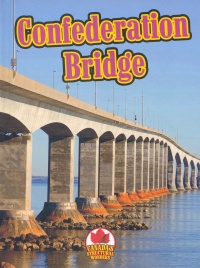| ________________
CM . . .
. Volume XIX Number 19. . . .January 18, 2013
excerpt:
Confederation Bridge, part of the “Canadian Structural Wonders” series, takes the reader from the planning stages of the bridge to its completion. The text is broken down into clearly labelled sections, typically two pages long, with several one-paragraph entries providing information on various aspects of the bridge and its construction. With the book’s having glossy colour photo illustrations complementing the text and facilitating comprehension on every page, readers are sure to stay engaged. The book begins with a timeline starting with the conception of the idea, following through to its completion. This is a great way to hook readers and make them want to read more. The glossary is a great feature, and use of the glossary is encouraged throughout the book. A short quiz about the Confederation Bridge, along with a section titled “Further Resources”, are other fantastic features. Overall, the text does a good job presenting facts about the Confederation Bridge in an interesting and concise manner, but the sections do not always flow. For example, near the end of the book, there is a section titled “Similar Structures Around the World”. I was surprised to find “Issues facing the Confederation Bridge” on the next page along with instruction for building a marshmallow and toothpick bridge, followed by a quiz and further resource on the Confederation Bridge. Considering the layout of the rest of the book, it feels it was decided to keep the two-page “Similar Structures Around the World” together, and “Issues Facing the Confederation Bridge”, along with the quiz and resources, were simply tacked on. Article use is not consistent throughout the book. The author almost always uses “the Confederation Bridge”, occasionally eliminates “the” for no clear, or grammatical, reason. The author does the same thing when referring to the Northumberland Straight. Rules around using articles for proper nouns are flexible, but the text would read better if articles were consistently used. Recommended. Crystal Sutherland holds Masters Degrees in Literacy Education and Library and Information Science. She lives in Halifax, NS, and is the resource librarian at the Nova Scotia Advisory Council on the Status of Women.
To comment
on this title or this review, send mail to cm@umanitoba.ca.
Copyright © the Manitoba Library Association. Reproduction for personal
use is permitted only if this copyright notice is maintained. Any
other reproduction is prohibited without permission.
NEXT REVIEW |
TABLE OF CONTENTS FOR THIS ISSUE
- January 18, 2013.
AUTHORS |
TITLES |
MEDIA REVIEWS |
PROFILES |
BACK ISSUES |
SEARCH |
CMARCHIVE |
HOME |
